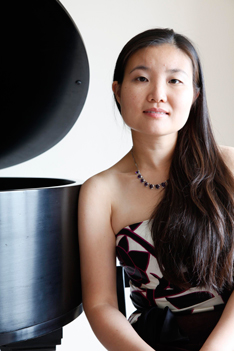 Mana Takuno’s excellent performance of an early, rarely heard 1901 work by George Enescu, his Suite No.2 in D Major, Op. 10, delighted me at a May 8, 2008 concert—(see review in Volume 15, No.3 of this journal) , and it made me want to hear more of her playing. I wrote that her exciting interpretation, with its “drive, virtuosity, textual and coloristic diversity”, stole the show from three other young pianists who shared the same concert with her. Ms. Takuno and her program of Poulenc, Thomas Oboe Lee, Beethoven and Schumann afforded me a more comprehensive “fix” on her achievement and pianistic capabilities.
Mana Takuno’s excellent performance of an early, rarely heard 1901 work by George Enescu, his Suite No.2 in D Major, Op. 10, delighted me at a May 8, 2008 concert—(see review in Volume 15, No.3 of this journal) , and it made me want to hear more of her playing. I wrote that her exciting interpretation, with its “drive, virtuosity, textual and coloristic diversity”, stole the show from three other young pianists who shared the same concert with her. Ms. Takuno and her program of Poulenc, Thomas Oboe Lee, Beethoven and Schumann afforded me a more comprehensive “fix” on her achievement and pianistic capabilities.
Ms. Takuno commenced with Theme Varie, which I believe was Francis Poulenc’s last work for solo piano. From the outset, the pianist captivated me with a warm, firm, beautifully balanced singing tone, and was alive to every intriguing turn of Poulenc’s whimsy. The second item was Thomas Oboe Lee’s 2009 Takuno Toccata, which was labeled a world premiere (it had been previewed in Boston a few weeks earlier on March 30th.) The work is skillfully written, and Ms. Takuno, the dedicatee, obviously found the Toccata tailor-made for her abilities and musical persona.
Alas, it pains me to relate that Ms. Takuno’s recital, after its auspicious beginning, turned out to be a surprisingly Jekyll and Hyde affair: Beethoven’s Sonata No. 28 in A, Op. 101 began wanly, and then promptly came with memory slips from which she never really recovered. The second movement March was too fast (for her comfort) and rhythmically and technically out of control. The poignant Largo-molto cantabile lacked concentration and intensity, and the Presto Finale was slipshod and lumpy. I will concede that this late-Beethoven Sonata is a tough nut for any young artist to crack, but I was a bit shocked that a player who I had believed to be as experienced and accomplished as Ms. Takuno would have been so technically over-extended and out of her element.
I was even more saddened by her inadequate performance of Schumann’s sublime Davidsbundler Tanze, Op. 6, a work which I had hoped would prove entirely congenial for an artist with an inclination to heartfelt Romanticism. Her version was to be sure “serious”, but it was also “boring”, as her tempos were prevailingly slow and heavy. Admittedly, I much favor Schumann’s earlier first version of the composition. The revised version, which Ms. Takuno validly preferred, burdens the attractive impetuosity and asymmetry with many portentous repeats, and furthermore expunges a few delectable details such as the held over note on the very first phrase and the delicious little pat on the backside at the end of No. 9. But the real problem with Ms. Takuno’s rendition was its technically labored pianistic deficiency (No. 13 was not so much Wild und lustig as muddled and desperate.)The virtuosity I had admired deserted her.
An encore, the Promenade penultimate movement from Schumann’s Carnaval, Op. 9 gave us more of the same, but, fortunately, a second encore—which I am told was part of Thomas Oboe Lee’s 20-9 Fireflies Book III, “Like a Music Box”—let us glimpse anew at the tonal beauty and refinement that had delighted me in Ms. Takuno’s playing in the early stages of her program.
My conclusion is that she is certainly gifted but also a “work in progress.”

 Pianist Mikhail Lifits is on quite a winning streak. At his recent solo recital as First Prize winner of the Hilton Head International Piano Competition, his impressive biography did not even list his top prize in the Busoni Competition, which he had won too recently to list!
Pianist Mikhail Lifits is on quite a winning streak. At his recent solo recital as First Prize winner of the Hilton Head International Piano Competition, his impressive biography did not even list his top prize in the Busoni Competition, which he had won too recently to list!